- Perspective – November 2023
- Columbus Stainless Advert
- Best of the GPS Newsletter
- State of the Stainless Steel Nation
- Education & Training
- NDE Advert
- Global Webinar Report Back
- Industry Insight – Price of Carbon Emissions
- Member News Cronimet
- Cronimet Advert
- Market Intelligence – Zambia: A rising economic powerhouse
- Professional Profile – Jeanré Hanekom
- Technical Case Study
- Fastenright Advert
- Technical Case Study
- Industry News – Manufacturing Indaba 2023
- Sassda News – Gauteng Golf Day
- Member News – Columbus Stainless Awards
- Obituary – John Rowe
- Pferd SA Advert
BATTLE OF THE ‘SIPS”: UNLEASHING THE POWER OF STAINLESS STEEL IN WATER SOLUTIONS
How does stainless steel compare to plastic alternatives in drinking water applications?
Stainless steel and plastic are both materials commonly used in various applications, including those related to water management and Sustainability. Should one compare these two materials in terms of sustainability, the following needs to be considered:
Environmental Impact - The production of stainless steel involves mining and refining raw materials (iron ore, chromium, nickel), which can have environmental impacts. However, stainless steel is highly durable and can be recycled, reducing the overall environmental impact over its life cycle. On the other hand, plastics are derived from fossil fuels and are associated with environmental concerns such as pollution and resource depletion. Some plastics can be recycled, but not all are easily recyclable, leading to issues like plastic pollution.
Recyclability - Stainless steel is highly recyclable with a global recycling rate of 96%, and the recycling process is energy efficient. This contributes to the circular economy and reduces the need for new raw materials. While some plastics are recyclable, the recycling process is not as efficient as that of stainless steel. Moreover, certain types of plastics may not be recyclable at all, contributing to environmental pollution.
Durability - Stainless steel is known for its durability and corrosion resistance. It has a long lifespan and can withstand harsh environmental conditions, reducing the need for frequent maintenance and costly replacements. Plastics are less durable than stainless steel, and their integrity can be compromised over time due to factors such as UV exposure and temperature variations. This can lead to the need for more frequent maintenance and replacements.
Life Cycle Costs - While the initial cost of stainless steel may be higher, its durability and minimal maintenance requirements can result in lower life cycle costs over the life span of the installation. The initial costs for plastics may be lower, but maintenance and replacement costs can accumulate over time, potentially making the life cycle costs higher. The International Stainless Steel Forum (now known as Worldstainless) published a study in 2020 based on statistics from the Republic of South Korea where stainless steel was compared to plastics in water applications with an expected life span of 100 years. This is illustrated in the graph below.
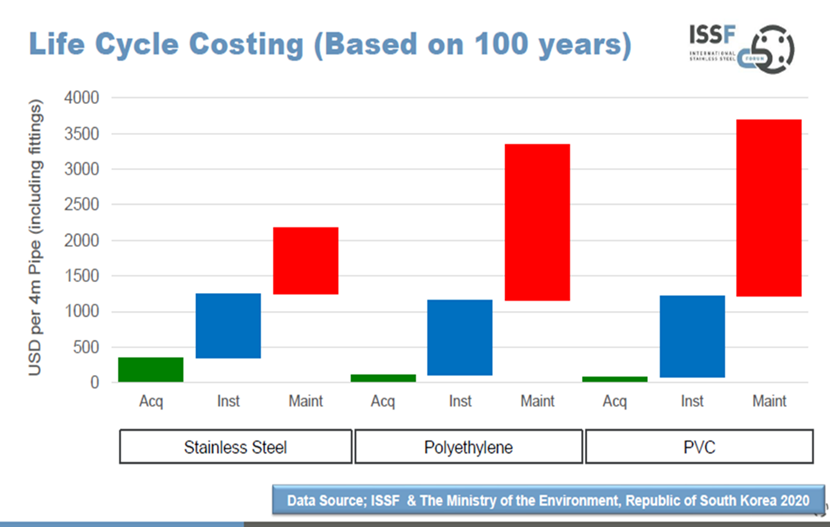
Chemical Resistance - Stainless steel is resistant to corrosion and can withstand exposure to various chemicals, making
it suitable for applications where water may contain corrosive substances. The chemical resistance of plastics varies. Some plastics may be susceptible to chemical degradation over time, limiting their use in certain water treatment applications.
End-user or consumer health and safety - Stainless steel (or its alloying elements) does not leach into the environment due to its passivity. Stainless steel is considered a safe and inert material for contact with drinking water. The risk of contamination through leaching of harmful substances from stainless steel is minimal under normal conditions. Stainless steel is an alloy of metals, primarily iron, chromium, nickel, and molybdenum, which form a protective oxide layer on the surface of the material. This oxide layer, also known as the passive layer, helps prevent the leaching of metals into the water. However, some factors can influence the leaching potential of stainless steel:
Grade of Stainless Steel: Different grades of stainless steel may contain varying amounts of alloying elements. High-quality stainless steel, such as 304 and 316 grades, is commonly used in applications involving water contact due to its corrosion resistance and stability.
Water Chemistry: The chemical composition of the water can affect the corrosion resistance of stainless steel. For example, exceptionally soft or acidic water may lead to more corrosive conditions and could potentially affect the passive layer.
Temperature: Elevated temperatures can sometimes increase the corrosion rate of stainless steel. However, for normal drinking water temperatures, this is typically not a significant concern.
Contact Time: Prolonged contact between water and stainless steel may increase the risk of leaching due to stagnant conditions that lead to oxygen deprivation in the chemical degradation over time, water, but this is not a concern for typical water usage scenarios.
Surface Finish: The surface finish of stainless steel can influence its corrosion resistance. Smooth, polished surfaces are less prone to corrosion than rough or pitted surfaces.
Microplastic contamination in drinking water is a growing concern worldwide. Microplastics are tiny particles, often less than 5 millimetres in size, that result from the breakdown of larger plastic items or are intentionally manufactured at a small scale. These particles can be found in various environments, including oceans, rivers, and even in the air. There is evidence that microplastics have made their way into drinking water sources, and consequently, into the water we consume. Some key points regarding the extent of microplastic contamination in drinking water:
Global Presence: Studies have detected microplastics in tap water samples from various countries around the world. This indicates that the contamination is not limited to specific regions but is a widespread issue.
Water Sources: Microplastics have been found in various water sources, including rivers, lakes, and groundwater. Some studies have also identified microplastics in bottled water.
Particle Types: Microplastics can be categorised into primary microplastics (manufactured at a small scale, e.g., microbeads in personal care products) and secondary microplastics (resulting from the breakdown of larger plastic items). Both types have been found in drinking water.
Health Concerns: The potential health impacts of consuming microplastics in drinking water are still under investigation. Some studies suggest that microplastics could carry chemicals and contaminants, and there is concern about their potential to cause harm to human health.
Monitoring and understanding the extent of microplastic contamination in drinking water are crucial steps in developing strategies to mitigate the impact on human health and the environment. Stainless steel would play a critical solution. This risk is already a key topic of discussions around the current South African water ‘landscape’ and the subject of a comprehensive study of microplastics in freshwater environments by NWU for the Water Research Commission was released in 2018.
As part of the recommendations in the study, it was mentioned that given that microplastics were found in drinking water, there is a need to explore sources as in some cases the water is conveyed using PVC pipes, as well as other types of conduit, pump, and reservoir elements which may also contribute microplastics to drinking water after treatment and release into the reticulation system. In South Africa, water is increasingly being reused, thus the levels of microplastics need to be evaluated within the whole water value chain.
Saving a critical resource - drinking water
Stainless steel itself does not directly contribute to saving drinking water; rather, it is a material commonly used in various applications that support water conservation efforts. The impact on water conservation comes from how stainless steel is used in different water-related systems and applications. Tokyo and Singapore have implemented various measures to manage and conserve drinking water, and the use of stainless steel in certain applications has played a role in these efforts. While the specific details of water management strategies can vary between cities, here are some general points about how Tokyo and Singapore have utilised stainless steel in their water management practices:
Tokyo, Japan:
Water Infrastructure: Tokyo has invested in a robust water infrastructure system, including the use of stainless steel pipes for water distribution. The durability and corrosion resistance of stainless steel contributes to the longevity of the water distribution network, minimising leaks and losses.
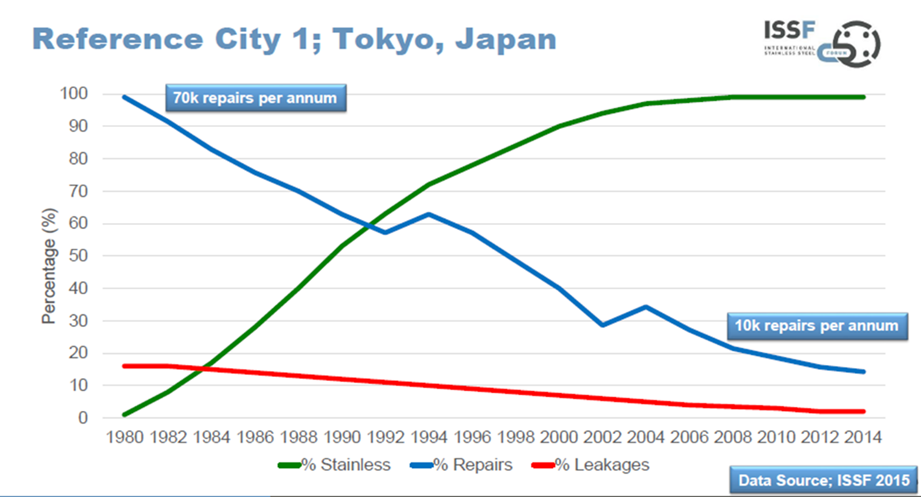
Water Treatment Plants: Stainless steel is commonly used in the construction of water treatment plants and equipment. Tokyo’s water treatment facilities utilize stainless steel for components such as tanks and piping, ensuring the reliability and efficiency of water treatment processes. Water Conservation Initiatives: Tokyo has implemented water conservation measures, including public awareness campaigns, to encourage residents to use water efficiently. While stainless steel may not directly contribute to these initiatives, the overall efficiency of the water infrastructure, which may include stainless steel components, minimise water losses.
Singapore:
'New' Water and Desalination: Singapore faces challenges with limited freshwater resources, and it has implemented innovative solutions such as
'New' Water (reclaimed water) and desalination. Stainless steel is often used in the construction of equipment for water treatment processes, contributing to the reliability and efficiency of these technologies.
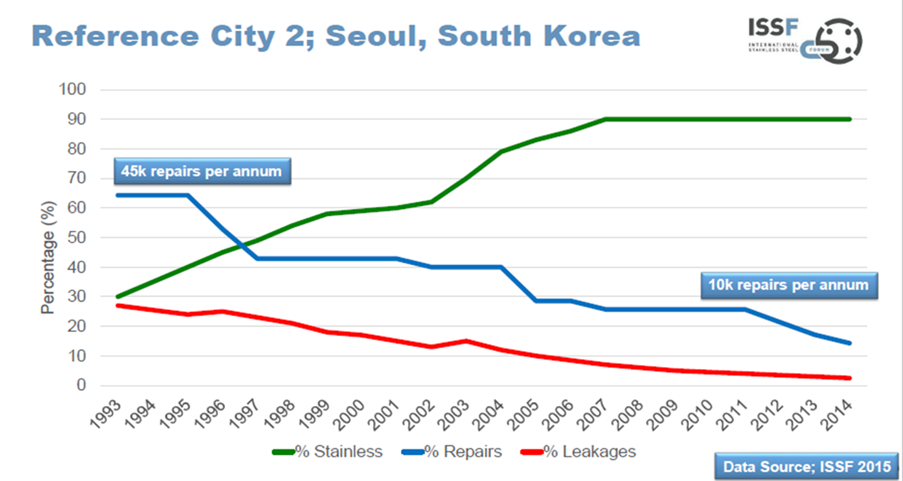
Water Recycling: Singapore places a strong emphasis on water recycling and reuse. Stainless steel, with its corrosion resistance and durability,
is suitable for use in the construction of pipes and tanks in water recycling systems, helping maintain water quality and minimising the need for frequent replacements.
PUB’s Active Management: The Public Utilities Board (PUB) in Singapore actively manages water resources, including monitoring and reducing water losses in the distribution network. The use of durable materials like stainless steel in infrastructure contributes to minimising leaks and losses.
Both Tokyo and Singapore have adopted a combination of technological innovation, infrastructure development, public awareness, and policy measures to ensure sustainable water supplies and efficient water use. The selection of materials like stainless steel contributes to the overall effectiveness and reliability of their water systems.
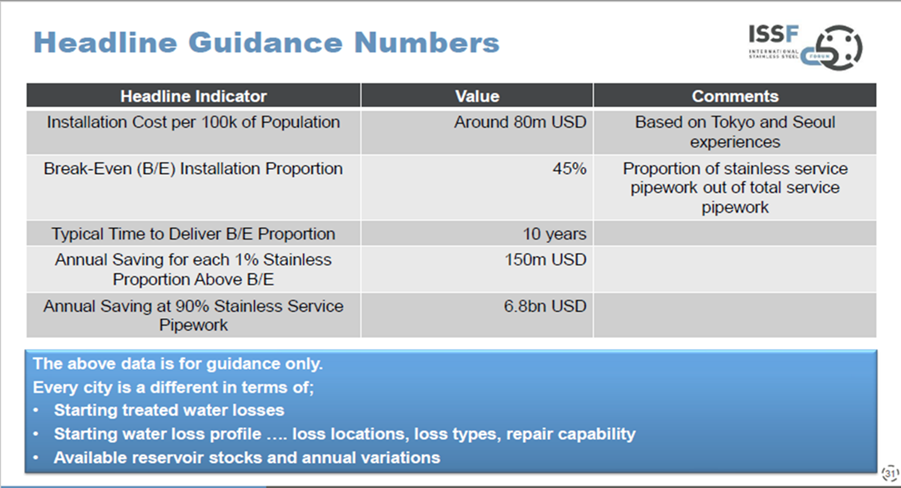
South Africa:
In South Africa, the issue of water conservation will remain critical as we enter the future of climate change. The graph on the right shows how effective stainless steel can be in curbing losses of drinking water in distribution systems according to Worldstainless.
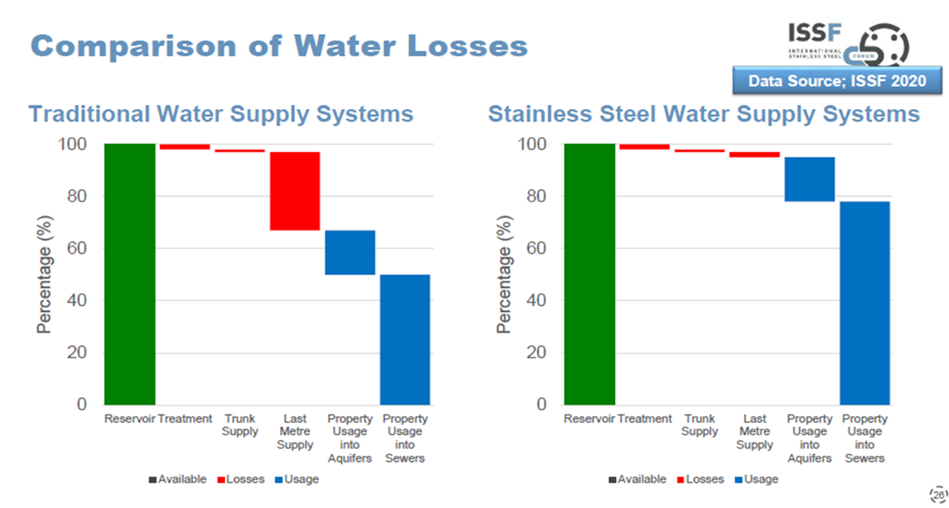
The Drakenstein Municipality in the Western Cape adopted a similar approach to the conservation of drinking water two decades ago. The municipality brought down water losses through leakages from more than 35% to around 10% by strategically using stainless steel for key
applications above and below street level.
Conclusion:
In summary, both stainless steel and plastics have their advantages and disadvantages in sustainable water applications. Stainless steel is more durable and recyclable, with a longer life cycle, but it may have a higher initial cost. Plastics, while initially cost-effective, pose environmental challenges and have limitations in terms of recyclability and durability. The choice between the two materials should be based on the specific requirements of the water application and broader sustainability goals. However, this choice sometimes call for tough decisions. Bad material choices today can add to the financial and environmental burden of tomorrow.

